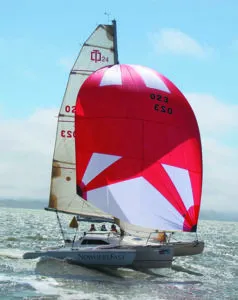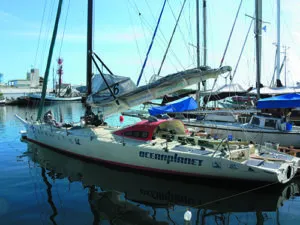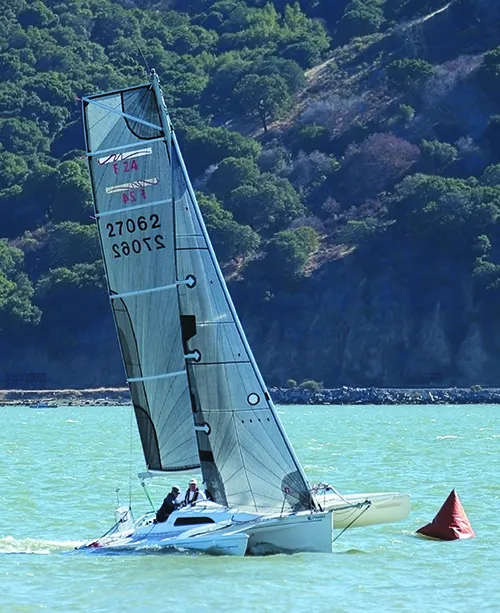The triangular mainsail of a Marconi rig has never been the most aerodynamic shape. The narrow tip produces wasteful tip vortices and little lift.
Developmental catamaran classes began experimenting with full-length battens and massive increases in roach, but the sails were hard to shape. The leach would hook to windward if the sail was too full or over sheeted, and when the sheet was eased, the fullness at mid-hoist tended to bag out and clog the slot.
Continuing experimentation, most notably on windsurfers and C-class catamarans, led to an extended top batten and a straighter leach, variously called a square-top or fat head mainsail. Traditional mains were soon scoffed as “pinheads” in racing circles. The straighter leach allowed better control and the square top improved aerodynamics and control in gusty winds. Since their introduction, they’ve gradually taken over many racing classes.
But are square-top mainsails better for cruising boats, or are they the latest fashion accessory? For cruising boats that already use high roach sails, are they the next step, or are they a just racer thing? We’ve owned and sailed pin heads, high roach sails, and square tops, interviewed sail makers with most of the major lofts, and have come to the clear conclusion that it depends.
Observation
The most obvious compromise is losing your fixed back stay. On many multihulls this isn’t such a big deal; the cap shrouds lead to the outer hulls and jibs are small, requiring less forestay tension. Fathead mainsails use full-length battens, a lot of roach, and relatively heavy mast sections not only because heeling force and weight aloft were a little less damaging, but also because multihulls like a main that can be feathered to windward and depowered quickly in gusts.
Monohulls, on the other hand, typically carry an overlapping masthead jib that requires substantial forestay tension to set properly, and the simplest way to get that is a backstay. The backstay won’t clear much roach or any significant square top at all. A B&R rig will work, of course, but forestay tension is a challenge, jib size is limited, and running backstays are probably a good idea if you plan to push it.
The most commonly stated advantage is increased sail area and thus speed. However, side-by-side testing has shown this is not as black and white as it appears. To windward, pinhead (or very moderate fat head) sails will generally point a little higher, while fatheads are a little faster. Off the wind the result is clear; more area is faster.
How does the area compare to a high roach sail? Curiously, it’s not much different. Area is added farther aloft, but area is subtracted farther down by the straighter leach. The wind is stronger aloft, but the upper portion of a square top opens rather easily in strong winds. As a result, the total power on most points of sail is little different than a high roach sail.
Trimming
Fat head sails are sometimes described as being like an “automatic reef.” We think this is an enormous stretch of the truth, considering the sail has more area, higher aloft.
A more accurate description might be smoother power since the leach will open in the gusts. However, we find the reefing point is not that different. Again, much of the confusion stems from comparing an old bagged-out sail to a new sail; any new sail will behave better in rising wind.
It is sometimes stated that square-top sails are easier to trim, but we think a more accurate explanation is that it is different. In light winds, high roach and pinhead sails twist off easily enough if the mainsheet is eased and the traveler is kept well up.
Square-tops, on the other hand, sometimes close up at the top when the wind lightens for a moment, requiring more active trimming in light air. This is an unfortunate corollary to “popping open” in the gusts in moderate winds. In stronger winds it takes monstrous mainsheet pressure to keep the top from twisting off more than desired, though whether this is a problem depends on the boat and how stiff it is. Vang tension is generally less up wind, since the boom must be free to rise, and more off the wind, since there is more leach to pull in.

Reefing
When an aggressive square-top sail is reefed, instead of retaining a roughly elliptical profile, the sail becomes progressively rectangular or even square, resulting in frankly, weird sail trimming properties. For this and other reasons, a 40% foot length is fairly standard for racing boats. Up to 70 percent is possible, but we think a more moderate 25 to 30 percent is the most a cruising boat should consider.
An aggressive square top sail will need to be reefed further to reduce area the same amount and to lower the center of effort. This can lead to a comically square sail where the leach has very little support. Additionally, because the head is now well below the forestay, the mast can be pulled out of column aft unless there is a lot of pre-bend built in or an inner stay. This is a big advantage of pinhead sails; when reefed, the area goes down with the square of luff length, instead of linearly as it does with an aggressive square top. As a result, a deeply reefed pinhead sail still reaches high enough to support the mast, whereas an equivalent heeling moment reefed square top may not. I’ve seen masts invert this way, and it’s scary. For any cruising use, we recommend a moderate square-top, designed to maintain a good shape when reefed.

Higher Cloth Stress.
At first blush, the answer seems obvious; with that big panel to support up high, the stress on the leach must be terrific. But in practice, we are seeing that the shape of a well-constructed square-top holds up better than a high roach or pinhead sail. Because the cords are longer up high, the stress is spread across more cloth.
Additionally, the upper battens tend to be quite stiff, eliminating leach hooking. The end result is that instead of the draft blowing aft as the leach stretches, the wear is more even and the sail holds its shape reasonably well. I would not have expected that, but that is the report, from many classes and that is also our experience.
That said, these are high-aspect sails and a low-stretch cloth is indicated. Racers will chose a laminate including Mylar and one of several high modulus fibers, including carbon, aramid blends and Dyneema. These materials hold their shape, nearly invariant, for the life of the sail, but they are prone to spectacular rips and delamination as they near the end of that life, which isn’t always that long in the sun.
Cruisers want the durability of polyester, but with the least possible stretch. Highly biased fabrics can work for triradial constructions. Hydra Net (by Dimension Polyant)—a combination of polyester and Dyneema—has earned a strong reputation for both low stretch and round-the-world durability.
Our advice is to listen to your sail maker, since the best choice depends on the sail design and the construction method. But yes. It’s going to be a little more expensive than a pinhead or high roach sail.
Furling
The top batten generally runs at a sharp upwards angle, preventing normal furling. On smaller boats it is easy to just slip the batten out. It takes only moments, and we normally do this at the dock or at anchor as part of the covering process, since leaving a few feet of sail up doesn’t really affect docking. Larger boats use a system where halyard tension and a small tackle locks the headboard into the top luff car as the sail is hoisted. Although it takes a few trials to master the procedure, we’ve found it painless and reliable. The Doyle Anomaly System is probably the best known system.
Full-length battens, found on both high roach sails and square top sails make furling on the boom a breeze. Fewer lazyjack lines are needed, and they can and should be positioned further forward, to minimize problems with fouling on battens when hoisting. Properly located, once 1/3 of the sail is hoisted, the batten tips are well aft of the lazy jacks.
Full-length battens also have their drawbacks. They create a compression load on the luff end, requiring a ball bearing luff car system for sails over about 300 square feet. Off the wind they can chafe on cap shrouds, though if fitted with chafe guards this is not a problem. Trimming the main in a bit and reaching downwind also helps.
Conclusion
The advantages of a square-top mainsail for racing are not disputed. They are faster around the course. But on a typical cruising boat, we think they are more of a fashion accessory than an improvement. Why do we see them on every new charter cat? Because they are selling the dream. Every sailmaker we interviewed said that the main reason they supply them for these boats is that they look cool. If you ask for one, they will sell it to you, but only if you ask. Otherwise, they will recommend pinhead or full batten high roach sails, according to the boat’s requirements.
To us, there is something about a racy square top sail set high above a condomaran with a flybridge that just doesn’t add up. Like slapping an oversized spoiler on the economy car you drive to the office, you won’t experience the advantages, but you’ll live with the downsides every day. Whether you like the look, I suppose, is personal.
How do they sail? In lighter winds it’s a little weird slacking the sheet in the lulls and pulling in the gusts; we find ourselves trimming more actively than with a high roach or pinhead sail. When it starts to blow, trimming is a little less active, but more sheet tension is required to control the leach. Reefing way down looks like a problem with a radical square top, but presumably only a racer would consider that. Overall, we like square top sails on performance boats, but not as much for cruising.
Related posts: Finding Balance with Your New Fathead Sail
Fad or Function? Fathead Sails Offer A Little of Both








































You forgot to mention that a square head sail require less battens since you have a straigh leech making the sail lighter.
I’m considering square tops for our 39 ft Freedom Schooner – no stays at all means much flexibility and I want to eliminate the needs for spinnakers or other light air sails…….but I do wonder how our two flexible masts will interact with the higher up sail area…..
rats- I just saw the “reply” button. apologies.
greg- I have a wyliecat39 with just a big main. having Ulman out of Santa Cruz CA build me a new sail. flat top. Our big carbon rig bends and spills air out the top when hit with a big gust.
Dave Hodges owns/runs the loft down there. He’s build my sails for 25 years. He’s a Moore 24 guy and all around amazing sailor. you might give him a call.